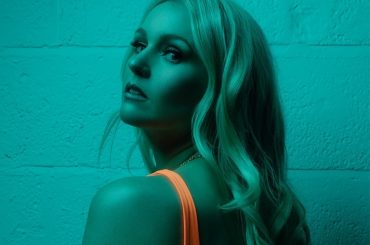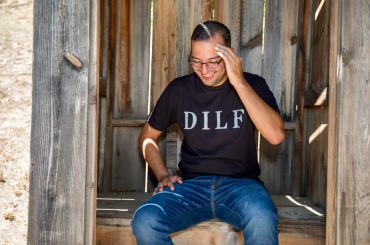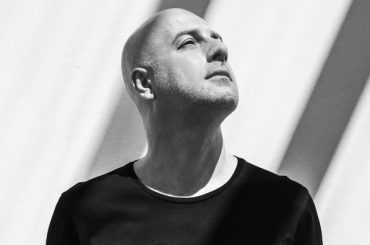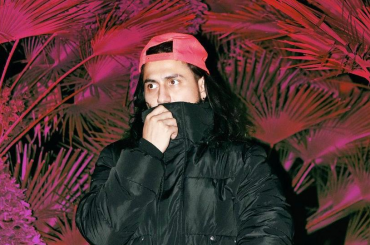Flushing, N.Y. – It’s late April and, in a strange scheduling quirk, the Atlanta Braves have returned to Queens for their second Citi Field series of the young season. It’s a decent crowd for a Wednesday, but things aren’t going so well for the local nine this spring evening.
Already down five runs, the Mets are trying to quell another Braves rally when mop-up reliever Fernando Salas induces an agonizing roller to the left of Mets’ second-sacker Neil Walker. Apparently imbued by the spirit of iron-fisted infielders of Mets past (namely Ken Boswell), Walker stretches out for the ball, only to have it clank spectacularly off his glove and shoot into short right field. Another run comes around and Citi Field lets out a collective groan.
Meanwhile, DJ Razor looks over the proceedings from his media booth, situated behind home plate and perched above the walkway behind the Excelsior Gold section of seats, not far from the TV and radio announcers. Working a pair of Macbook Pro laptops and a Numark NS7 III controller – fully skinned with colorful Mets logos – Razor gets busy prepping for the looming 7th inning stretch and the extra time he’s required to fill.
Within minutes, the restless crowd will be on its feet singing the traditional “Take Me Out to Ballgame,” then the regional fave “Lazy Mary (Luna Mezzo Mare),” and eventually mass-pogoing to evergreen hip-hop hit “Jump Around.” In favor of some temporary joy, the infield misdeed seems to be forgotten. But that’s what a good DJ can do if he pushes the right buttons, and Razor (aka Peter Osback) been doing that for most of his life.
Of course, playing to big crowds is nothing new for Razor. Working with Guido Osorio to comprise the Long Island-based DJ/producer team Razor N’ Guido, he had a big hand in creating the sound of New York clubland. After years of DJ and studio work, the duo broke out and, between 1998 and 2001, had a string of huge club and chart hits, including dancefloor scorchers “Do It Again” and “Miss the Way” (feat. Reina).
Additionally, RNG remixed hits for a wildly diverse range of artists including The Notorious B.I.G., Deborah Cox, De La Soul, Björk, Club 69, Kim English, Isaac Hayes, and Madonna. The duo’s fusing of hard-house sounds, tribal percussion and hooky elements opened touring opportunities and late-night gigs at some of New York’s most legendary clubs, like Twilo. (Sadly, Osorio passed away in early 2016 at the age of 46.)
Now working each home game for the New York Mets, the Major League Baseball club he’s always loved, Razor has become quite comfortable spinning sporting events. In fact, in 2015, when the National Hockey League’s New York Islanders moved its home games from Long Island’s Nassau Coliseum to Brooklyn, he was invited to join them in the Barclays Center DJ booth. Combining both clubs’ home schedules, that’s 122 regular-season home games a year, playing in front of about 3.3 million New York-area sports fans.
In addition to catching a ballgame at Citi Field, we caught up with DJ Razor to discuss the special challenges presented by spinning sporting events, his deep DJ background and the unique musical partnership he shared with Guido Osorio.
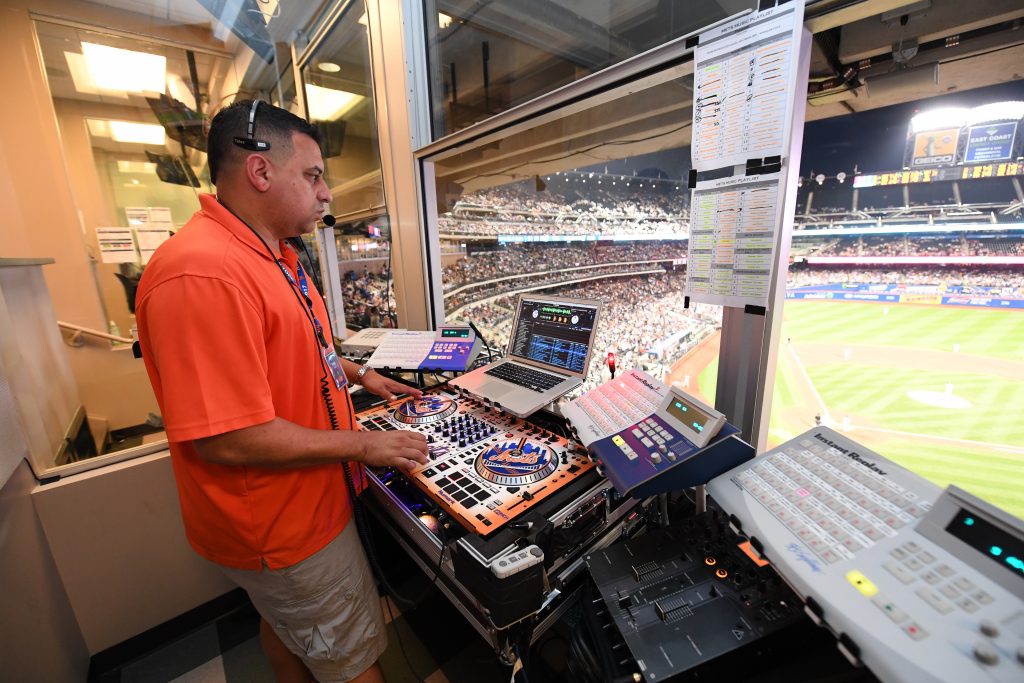
DJ Times: How’d you get the nickname Razor?
Razor: In 1988, I was the DJ in a rap group called Steppin Razor. The other guys said I was sharp with my cuttin’ and scratchin’, and the name stuck. The funny thing is I didn’t even have my first set of turntables yet, just one belt-drive turntable, a tape machine with a good pause button, along with my Radio Shack mixer, which didn’t have a crossfader. I was just cutting with the faders, but I made it work because I had to.
DJ Times: Tough way to get started…
Razor: It was hard work, and it wasn’t until a decade later that my remix partner Guido and I began seeing the benefits of our work under the moniker Razor N’ Guido. Our remixes and original productions for artists like Notorious B.I.G. and Madonna were being played on the radio stations we grew up with – and that was really amazing.
DJ Times: What kind of music first attracted you?
Razor: When I was in grade school, most of the school kids listened to metal, but I was inspired by the percussion and rhythm of freestyle, rap and house. One of my favorites was Newcleus’ “Jam On It,” which has its roots in funk and disco, too. It’s got a phat baseline and some bouncy percussion.
DJ Times: What inspired you to actually DJ?
Razor: My cousin Rio was a DJ, so by the time I was 10 or 11, I had begun sneaking into the club and hiding in the DJ booth. I was really into the music and breakin’ scene. Rio was a big influence on me, so when I saw people react to the songs he played and the way he put them together, I knew this was what I wanted to do. So, I got a job at a bagel shop and a Chinese restaurant, and saved up to buy DJ equipment. Once I had enough saved to buy turntables, I gave my two weeks’ notice. Soon after that, I bought my first vinyl – “Must Be the Music” by Secret Weapon and “Rapper’s Delight” by The Sugarhill Gang. I still put them in my sets to this day.
DJ Times: How did the sports gigs come about?
Razor: Growing up, I was a huge fan of baseball and spent lots of time at Mets games. You can’t imagine the thrill [Guido and I] felt hearing our hit song “Do It Again” at Shea Stadium. I dreamt of meeting the people who played our song for the crowd, never knowing that one day that would be me. I began to foster a relationship with some of the guys involved and, through hard work and perseverance, we got the gig scoring the fireworks shows. As that relationship evolved, I became the Mets DJ for their home games, which is a real dream come true. At the end of baseball season, I was approached by the Islanders, whose season began just a week later – and, of course, I accepted! Now I’m thinking: What other sports do I love? It’s been an incredible opportunity.
DJ Times: For the Mets, how do you approach game day?
Razor: The Mets are about entertainment for everybody. Before the gates open, I’m playing music for the players. Season ticket holders get early passes, so I’m always watching the crowd, and change the music depending on who’s there and how they react. When the gates open, the crowd is diverse, and I’ll usually go into some radio hits. In the moments before the game, I want to fire up the crowd, so that’s when I really bring up the energy. Then it’s game time, and there really is no playbook, you just gotta know what to hit them with and when.
DJ Times: What’s unique about this gig? What special skills does it require?
Razor: The fans don’t realize that by the time the first pitch is thrown, I’ve already spent the whole day selecting the right music and doing on-the-fly edits to make them work for any situation. It’s not as easy as it sounds. Most tracks are only played for 30 seconds during the game, so tight editing is critical. Anyone who knows me understands the importance I place on good edits. I learned to cut physical ¼-inch tape and edit on the TASCAM 34B [4-channel, reel-tape recorder], and I think it shows in the precision of my cuts. In the digital age, I can bring those skills to a laptop, which is good because tape-editing machines weigh a ton!
DJ Times: What’s your setup at Citi Field?
Razor: I love my Numark NS7 III [4-channel DJ controller with screens] because it feels like the old-school turntables I learned on. My hardware is two MacBook Pros, one for effects and one for back-up, running Serato DJ software and three [360 Systems] Instant Replay systems. Plus, I have a ton of other toys for generating effects at my disposal.
DJ Times: Spinning live for a sporting event in an active venue obviously has its own challenges. I see you’re on an earpiece with other people discussing upcoming music and scripted moments for the evening. How does that work?
Razor: When I DJ at clubs, I only have to listen to two songs and the crowd. At the ballpark, there’s a lot in my ears, and it takes some getting used to. In addition to the music I’m mixing, I hear TV and radio broadcast, official scorer, camera ops, scoreboard techs and various others. In my headset, I have the director of the ballpark keeping everything in sync and letting me know what’s next and when it’s my turn to go. We talk before the game and listen to some new music and edits and decide what works. We also have a game log we follow for inning breaks/commercials and other events. But during the game, anything can happen, so I always have to be on headset. It takes great focus and, at this level, mistakes are not an option.
DJ Times: You also work the Islanders games at Barclays Center. How are the gigs different?
Razor: The music is very different for each. Baseball is fast-paced at times and things can change even faster. But I’ll always have the end of the inning to reset and catch my breath for the next inning. Hockey is more abrupt – surprises can happen even quicker. They can also stop at any time, so I have to be on-point and ready to cue the next track or effect on the fly. It’s an adrenaline rush, but I love the challenge.
DJ Times: Where else are you spinning these days? What music are you making?
Razor: I still love playing in the clubs when my Mets schedule allows. I love trying out new sounds. I have a couple of residencies in New York, and recurring gigs in Boston, Vegas and London. I’m still creating Razor N’ Guido remixes. Right now, I’m working on a remix with Richard Scotti for Lenny Fontana & D-Train, and just finished one called “Bomba” by Aggro Santos. I’ve also got an original project with my friend John Page that will be out soon. I don’t ever want to stop doing music.
DJ Times: Also, belated condolences on the passing of your studio partner, Guido Osorio. He was such a great guy, such a unique personality and so talented. Razor N’ Guido music very much defined a time in New York City clubland – helping push that tribal sound would seem to be your enduring musical legacy. But in your own words, what did partnership mean to you?
Razor: Let me start with there will never be another partner to replace him. He was everything to me and I will miss him more than words can express. In the beginning, the partnership was based on the winning production formula. We each knew our strengths, and they complemented each other. I knew the sound I wanted and where it should go, and he knew how to get there and make it sound incredible to your ears. We learned from and fed off each other and, at some point, he came to know what I wanted in a song without me telling him. Having a partner is easy, but having the right partner is key.
DJ Times: What was your studio process?
Razor: We had a system. I would work on vocals and arrangements, while he would lay down the sounds and handle the final mixdown. If I wasn’t sure on a track’s direction, I could always ask Guido and know his answer would inspire me to something even greater. He would always push for better sounds, even if it took days, and many tried to find them. Sometimes we worked separately, but we always completed a project as a team.
DJ Times: And the gigs?
Razor: Club gigs also had a process. He knew my style and I knew his, so we didn’t have any questions when it came down to who was playing what. It would really depend on who was playing first and how the crowd was responding. Sometimes I would open the room and test the waters and then sometimes he would start – we often didn’t know until we got there. Sometimes I would jump in his set and play something and sometimes we would both play at once. It wasn’t unusual to have four tracks going at once.
DJ Times: Quite a team…
Razor: Guido was more than a partner – he was like a brother to me. We worked together and lived together, and always helped one another, no matter what the situation. I have learned so much from him and would not be in this position if we had never met. I am so grateful to call him my true partner.





